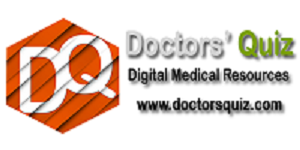HIGH YIELD POINT FOR MEDICINE 2015
http://www.doctorsquiz.com important topics for DNB-CET, AIPGMEE, FMGE, DNB-PDCET, UPSC-CMS online medical examination .
Diabetes insipidus(DI) is a condition characterized by excessive thirst and excretion of large amounts of severely diluted urine, with reduction of fluid intake having no effect on the latter. There are several different types of DI, each with a different cause.
The most common type in humans is central DI, caused by a deficiency of arginine vasopressin(AVP), also known as antidiuretic hormone(ADH). Vasopressin acts at the distal tubule and collecting ducts to increase permeability to water not a/w electrolytes i.e. free water. Hence central DI is a/w *free waterclearence. Under normal circumstances, this would result in the movement of free water from renal tubule to capillary. Under conditions of vasopressin deficiency, as in nephrogenic DI water remains in the tubules, resulting in excretion of dilute urine.
The second common type of DI is nephrogenic diabetes insipidus, which is caused by an insensitivity of the kidneys to ADH. Symptoms are similar to neurogenic DI except plasma levels of vasopressin are increased.
Plummer vinson's syndrome- Combination of symptomatic hypopharyngeal webs and Iron deficiency anemia in middle aged female. Presence of web is in postcricoid* region. Hemoglobin is low and there is hypochromic microcytic anemia. All cases have a low serum iron and high iron binding capacity. Iron shold be given orally to correct Hb levels.
Lofgren's syndrome- erythema nodosum, arthralgias, and bilateral hilar lymphadenopathy
AR-Peripheral signs------
1. Austin Flint murmur* may be heard in severe AR
2. Collapsing (water hammer) pulse*
3. Corrigan’s sign* (carotid pulsation)
4. de Musset’s sign* (head nodding)
5. Duroziez’sign* (femoral diastolic murmur as blood flows backwards in diastole)
6. Hill Sign -BP difference in upper and lower limb--> (UL
7. Quincke’s sign* (capillary pulsations in nail beds)
8. Traube’s sign* piston sound over femoral arteries
9. Wide pulse pressure*
READ MORE
http://www.doctorsquiz.com important topics for DNB-CET, AIPGMEE, FMGE, DNB-PDCET, UPSC-CMS online medical examination .
Diabetes insipidus(DI) is a condition characterized by excessive thirst and excretion of large amounts of severely diluted urine, with reduction of fluid intake having no effect on the latter. There are several different types of DI, each with a different cause.
The most common type in humans is central DI, caused by a deficiency of arginine vasopressin(AVP), also known as antidiuretic hormone(ADH). Vasopressin acts at the distal tubule and collecting ducts to increase permeability to water not a/w electrolytes i.e. free water. Hence central DI is a/w *free waterclearence. Under normal circumstances, this would result in the movement of free water from renal tubule to capillary. Under conditions of vasopressin deficiency, as in nephrogenic DI water remains in the tubules, resulting in excretion of dilute urine.
The second common type of DI is nephrogenic diabetes insipidus, which is caused by an insensitivity of the kidneys to ADH. Symptoms are similar to neurogenic DI except plasma levels of vasopressin are increased.
Plummer vinson's syndrome- Combination of symptomatic hypopharyngeal webs and Iron deficiency anemia in middle aged female. Presence of web is in postcricoid* region. Hemoglobin is low and there is hypochromic microcytic anemia. All cases have a low serum iron and high iron binding capacity. Iron shold be given orally to correct Hb levels.
Lofgren's syndrome- erythema nodosum, arthralgias, and bilateral hilar lymphadenopathy
AR-Peripheral signs------
1. Austin Flint murmur* may be heard in severe AR
2. Collapsing (water hammer) pulse*
3. Corrigan’s sign* (carotid pulsation)
4. de Musset’s sign* (head nodding)
5. Duroziez’sign* (femoral diastolic murmur as blood flows backwards in diastole)
6. Hill Sign -BP difference in upper and lower limb--> (UL
7. Quincke’s sign* (capillary pulsations in nail beds)
8. Traube’s sign* piston sound over femoral arteries
9. Wide pulse pressure*
READ MORE

No comments:
Post a Comment
Thank You ! We will respond as soon as possible.